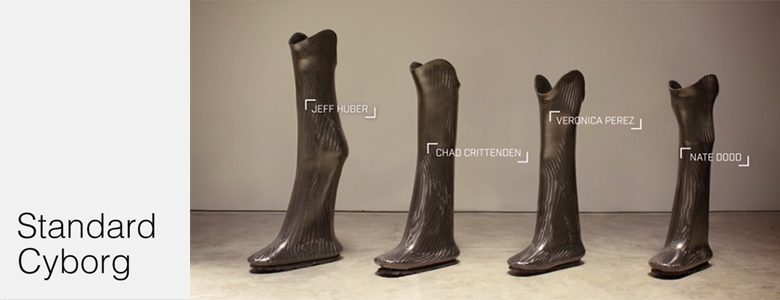
The amazing 3D printed Water Leg
Disability Horizons writer Nichola Daunton talks to Standard Cyborg CEO and Silicon Valley resident Jeff Huber, inventor of the 3D printed Water Leg, a low cost prosthetic limb that could change the way you shower, swim and hang out at the beach…
Jeff Huber has been causing something of a stir in the world of prosthesis since launching his start-up company Standard Cyborg. Based in Silicon Valley, Huber, a former engineering student has perfected the art of 3D printing and was responsible for creating the world’s first fully functioning 3D printed prosthesis; not bad for a 25-year-old.
Born with Fibular hemimelia (the same condition as Oscar Pistorius), Huber saw a gap in the market when it came to waterproof prosthetics and wanted to create a prosthetic that could be used safely at the beach or by the pool, without the fear of damage or rust.
By bringing 3D printing into the process and teaming up with Prosthetists, Huber and his team have been able to keep costs down and simplify the process of creating a prosthetic. First, a scan of your existing prosthetic leg is taken, then the data is sent to Huber and his team who print out a Water Leg using the scan, before covering it in carbon fibre and shipping it to your door. For those who aren’t tech experts though, perhaps an explanation of how 3D printing actually works wouldn’t go amiss, over to Jeff…
A lot of people (myself included!) find the concept of 3-D printing quite baffling, can you explain how your prosthetics are produced?
Essentially 3D printing is like a really fancy hot glue gun. It takes plastic and melts it and then creates another object out of it. If you were really patient, you could probably take an object like a coffee mug and create it with a hot glue gun by going slowly and carefully and building up each layer, as the layer beneath cools. The key insight is that you aren’t magically making an object appear. You are deconstructing the object into a couple of hundred “slices” or pieces that are then placed on top of one another.
What situations can the Water Leg be used in and how is it worn?
Our leg is perfect for the shower, beach or pool. I just came back from vacation and it was indispensable on the beach and in showers! It stays on via a suspension sleeve – a sleeve that goes over your leg and up your thigh.
You were born with Fibular hemimelia and had your left leg amputated below the knee when you were a baby, was your own experience the sole reason for setting up Standard Cyborg or were you inspired by other things too?
I would say it was a combination. Solving my own problem was obviously exciting, but solving a problem for millions of people is significantly more exciting.
Prosthetic limbs are often incredibly expensive, but by using 3D printing you’ve driven down the price of your prosthetic Water Leg. Is making your product available to large demographic important to you?
The price of our leg varies from clinical partner to clinical partner, but it is always below $2000. We are by far the cheapest option available. Thinking about impact is a huge part of what we do, we want every amputee to be able to have access to our leg if they want one.
Have you considered making waterproof prosthetic arms as well, or walking and running legs?
There are a ton of things I hear amputees asking about, and I have definitely received a lot of interest in those things. Right now though we are focused on getting the word out about this leg, and then we’ll see what people want next. There are definitely a ton of different opportunities available to us in the future, so we’ll see what happens.
Do you think being based in Silicon Valley, not the traditional place for prosthetic limbs to be manufactured, has helped you? Do you think the future of prosthesis lies in the tech field?
The field of prosthetics is actually really distributed across the nation, so I wouldn’t say that there is a historical nexus anywhere. Interestingly, many of the companies doing the most innovative things in prosthetics are actually also here in San Francisco. Silicon Valley’s mentality is that software and smart hardware can make the world a better place, and at our core we believe that software will improve the process and production of prosthetics. That’s not a common belief at the moment, but we know it’s the future.
Currently your prosthetics are only available in the United States, do you have any plans to expand globally?
We have had really amazing interest from all over the world. Prosthetics, at the end of the day are medical devices, and so we just need to figure out how to cooperate with governments around the world in order to get these products to their people too. Again, one of our main goals is impact, and wherever there are amputees, we want to be there too.
What is your vision for the future of Standard Cyborg?
I want medicine to expand and change its vision of itself, so it’s not just about fixing broken people, but instead it’s focusing on maximizing human potential. Prosthetics are where we are starting, but when I think about all the potentials of 3D printing tissues, organs and bone, I get really excited about what the future will hold.
To learn more about Standard Cyborg, you can visit the company’s website here.
